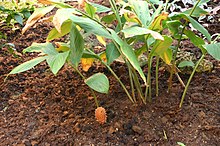Zingiber zerumbet
| Awapuhi | |
|---|---|
 |
|
| Scientific classification | |
| Kingdom: | Plantae |
| (unranked): | Angiosperms |
| (unranked): | Monocots |
| (unranked): | Commelinids |
| Order: | Zingiberales |
| Family: | Zingiberaceae |
| Genus: | Zingiber |
| Species: | Z. zerumbet |
| Binomial name | |
|
Zingiber zerumbet (L.) Roscoe ex Sm. |
|
Zingiber zerumbet (awapuhi), also known as bitter ginger,shampoo ginger (Malay = lempoyang) or pinecone ginger, is a vigorous species of the ginger family with leafy stems growing to about 1.2 m (3.9 ft) tall. It is found in many tropical countries. The rhizomes of Z. zerumbet have been used as food flavoring and appetizers in various cuisines while the rhizome extracts have been used in herbal medicine.
Z. zerumbet is a perennial. From autumn until spring it goes dormant above ground as the leafy stems shrivel and die away, leaving the pale brown, creeping stems (rhizomes) at ground level. In the spring, the plant springs up anew. The 10-12 blade-shaped leaves 15–20 cm long grow in an alternate arrangement on thin, upright stem to 1.2 m (3.9 ft) tall. Among the leafy stems, the conical or club-shaped flower heads burst forth on separate and shorter stalks. These appear in the summer, after the leafy stems have been growing for a while. The flower heads are initially green and are 3 to 10 cm (1.2 to 3.9 in) long with overlapping scales, enclosing small yellowish-white flowers that poke out a few at a time. As the flower heads mature, they gradually fill with an aromatic, slimy liquid and turn a brighter red color. The flower stalks usually remain hidden beneath the leaf stalks.
This plant, originating in India, was distributed eastward through Polynesia and introduced to the Hawaiian Islands in the canoes of early Polynesian settlers.
The juice can be used to quench thirst when out walking in the forest and can be combined with mountain apples as a meal.
In Hawaii, the spicy-smelling fresh rhizomes were pounded and used as medicine for indigestion and other ailments. The rhizomes can be stored in a cool, dark place to keep for use when needed. In traditional use, the rhizome was ground in a stone mortar with a stone pestle, was mixed with a ripe noni fruit and then used to treat severe sprains. The pulp was placed in a cloth and loosely bound around the injured area.
...
Wikipedia
